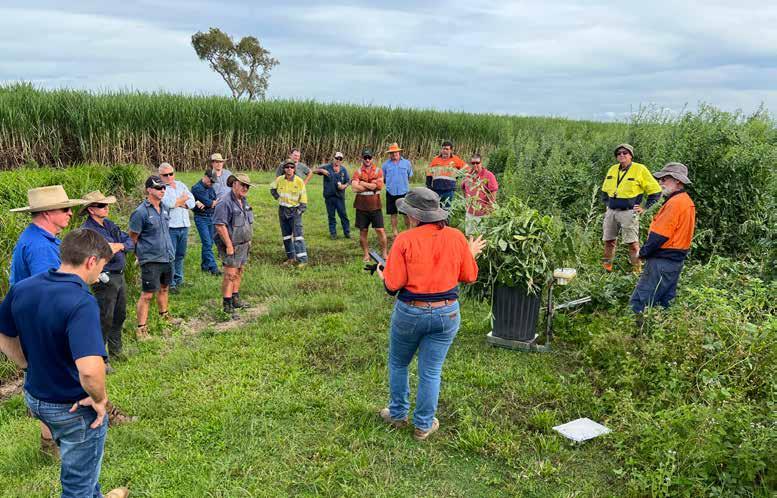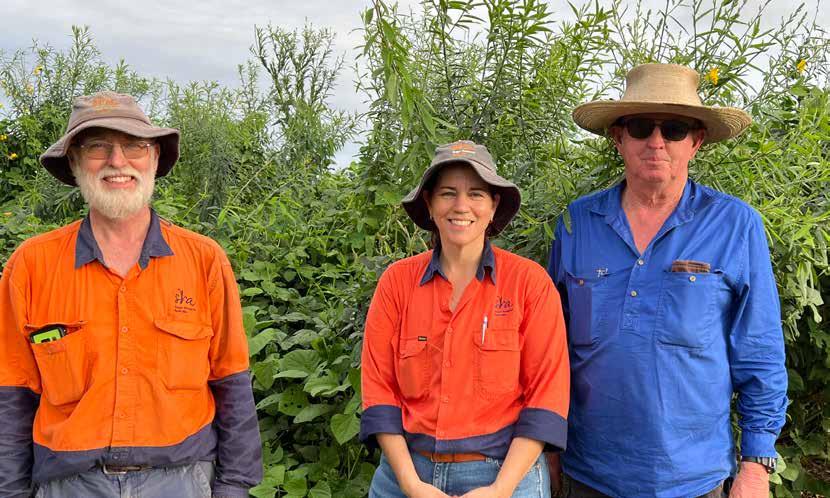
3 minute read
LEARNING FROM PEERS: COUNTING THE BENEFITS OF FALLOW COVER CROPS
Growers watch SRA team members demonstrate the process for measuring biomass in a multi-species crop.
LEARNING FROM
Advertisement
PEERS: COUNTING THE BENEFITS OF FALLOW COVER CROPS
High fertiliser prices have seen increased interest among growers to understand the value of cover crops in boosting nitrogen in their soil.
A recent peer learning session in the Herbert drew a strong turnout, as growers observed how to estimate nitrogen contributions from multispecies cover crops available to the following sugarcane plant crop, while learning from the experience of fellow farmer Alan Lynn.
Late on a Friday afternoon at Alan Lynn’s Ingham farm, around 15 growers watched on as SRA’s District Delivery Officer Glen Park and Principal Agronomist Dr Danielle Skocaj tackle an unenviable task.
Using pruning shears and a cane knife, they manually cut out a one-metre long section of a vigorous multi-species crop, loaded it in a bin, and onto scales.
So dense was the growth, famer Alan Lynn slashed a small adjoining section of the cover crop to enable Glen and Danielle to gain access to the site.
The tricky and tangled task demonstrated how to gauge the quantity or fresh weight of the crop, known as biomass.
“At the moment it’s the only way we can assess the biomass that's there,” Danielle said. “What we’re demonstrating is that it is quite difficult for farmers, especially in these multispecies cover crops, to calculate how much biomass is there.”
Understanding the biomass helps inform how much nitrogen (N) is potentially available to the following plant cane crop.

SRA’s Glen Park and Danielle Skocaj with grower Alan Lynn at the Herbert biomass peer learning event.
“We need to understand both fresh and dry biomass production in order to estimate potential nitrogen supply,” Danielle said.
“In the first crop we sampled, we estimated there were around 34 tonnes per hectare of fresh biomass. If we use an assumption of moisture content, then we then were able to say that there could be around 8.5 tonnes per hectare of dry biomass.
“By the time we account for the above ground biomass and the biomass below the ground, which is an additional 30 per cent, Alan has well in excess of 200 kilograms of nitrogen per hectare that could become available to his plant cane crop.”
“That’s a pretty good outcome, and in Alan’s situation he can be assured there’s no need to apply fertiliser N at top dressing. With the practices he follows to terminate the crop and manage the residue up until the point of planting, he's going to maximise how much of the N produced by the cover crop is available to the plant crop.”
Danielle said many growers were seeking ways to reduce costs in light of rising fertiliser prices.
“I think we’re going to see a lot of growers asking questions about where can I reduce fertiliser inputs without impacting productivity, especially plant cane nitrogen rates, following legume or multi-species cover crops?”
“Growers are always interested in understanding if I'm investing money into growing a crop during my fallow period where I may traditionally have a bare fallow, what are the benefits for me in terms of soil health, but also then the opportunity to look at potential nitrogen savings.”
Growers observing the demonstration peppered Alan with questions, as he explained his commitment to soil health.
“There are a lot of questions, especially in the paddock and they're genuinely interested,” Alan said. “I’m more about soil health and the nitrogen is a byproduct.”
Yet with the current cost of fertiliser, he acknowledged the nitrogen in his soil is “a very valuable commodity.”
“There’s a multitude of advantages - soil protection, weed control. There'll be no weeds in that block, so there’s less herbicide to use. It's a win-win situation,” Alan said. Tully Grower Ray Zamora made the trip to Ingham to attend the peer-to-peer session and said he valued the insights gained.
“Alan and I practice similar styles of farming but it’s always good to pick up a tip here and there,” Ray said.
He was pleasantly surprised at the available nitrogen calculation and will likely ease back on side dressing at his own farm.
“It certainly gives me more reassurance with what I’m doing. It makes it more attractive all the time,” Ray said.
Ray said he enjoyed catching up with peers at the event.
Ray Zamora | Tully Grower










